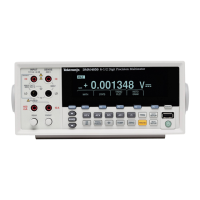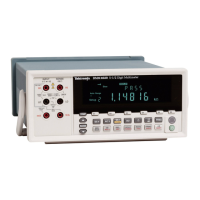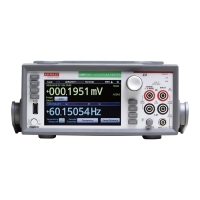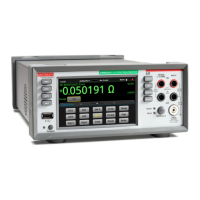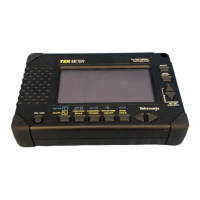Circuit protection
to
the ohmmeter
function is provided
by
posistor
RT1102 and
clamping
diodes CR1516
and
CR1518. A
voltage source inadvertently
applied
in
the
ohmmeter function
will cause RT1102
to
heat and effec-
tively open.
Temperature
Measurement
Circuitry
The temperature circuitry
is designed to operate with
the
P6601
Temperature Probe. The temperature
sensing
element
consists of a
thin-film platinum
resistor in the
tip
of
the probe. The sensor resistance, which is
a function
of
temperature, is; R
“
(R„ I aT T /?T^),
where R„
is
100
Q,
a
is equal to 0.3738
Q
per degree
C,
and
is
equal
to 8.85 x
10
'
Q/°C^
(nominal coefficient). T is temperature
in
degrees Celsius.
A
1 mA
current
source from transistor
01731.
zener
diode VR1636, and related
circuitry flows through
the
temperature
probe sensor. When the
temperature
changes, the sensor resistance changes, which
causesthe
voltage developed
across
the
sensor to change. This
voltage is shifted and amplified
by the Temperature
Amplifier
(U1737).
The output of
U
1737
(pin
6)
applies this
temperature
probe
signal to
a
network
consisting of
components R1931,
CR1935,
R1935,
R1932,
R1933,
CR1934, and
R1934. This
network helps compensate for
the
non linear function
of
the temperature probe. With
diode
CR1935 setting a break point at
an
equivalent
75"C
and diode
CR1934
setting
a
break point
at
approximately
125”C,
the output is somev/hat linearized and
equal
to
~1
mV/"C times
probe temperature.
When the front panel TEMP°
C
push button is
depress-
ed,
switch
Sl-N couplesthistemperatureoutputtoAnaIng
Converter
U1601
(pin
15).
Analog-to-Digilal Converter
The
analog-to-digital converter (a/d converter) in the
DM 501A uses a
Siliconix
type LU120 analog
converter
(U1601)
and a type LD121 digital converter
(U1603)
to
convert the analog
input
voltage to
a
digital representa-
tion.
The
Analog
Converter
{U1601)
contains an input
buffer-integrator-comparator and an auto-zero
amplifier.
The Digital Converter
(U1603)
contains the necessary
control logic for the analog convertor
as
well as the
buffers, multiplexers, latches, and counters needed to
drive
the
display circuitry.
The
basic
sensitivity of
the a/d
converter
is
2
Vfull scale
indication,
which
is set by
R
1505
(2
Vdc).
Th>
,^00
mV'
lull
scale input for the a/d converter
Is set
by
ni.5('4
(200
mVdc) when the relay K1505 is
;
iiorgi.
olI
.biougli
switches SI and
S2.
1
he 2 Vdc
0
(f!
1405)
is
i -ed lo set the
initial zero for the a/d converter A/hen
in
ti.o 2 /
hii!
scale
mode.
When the a/d convertei input
is sot
u .
2>
T
fail
scale mode, relays KI408 and
KI505
ate oii.
.yis
Kf. The
200 mVdc
0
(R
t4
15)
is now in
tti
a
circuit
t
j
a.- ,,.Si fsir
the
initial
zero
offset.
The
a/d
converter cporntes
on a
ci’.arge-bai.-incing
technique. The input voltage is
cor;
verted
to a
cur rent I fiat
charges integrator capacito,
Cl 500.
1
hr'
conv e ter counts
the units of charge
ne’Oded
to
keep the
ir.ieg:
si'
<
outfiut
near
zero.
(See Fig.
8-2
in the
Disyrams
s
'
tn-n.)
The conversion cycle
is
49,152
cluck
pulses long of
which
16,384
pulses are
used
in
the AUTO Zero (AZ)
interval
and
32,768
puls'rs
are used
in the nicasii;
e
i"lerval.
Auto-Zero
Period
The
a/d converter systei.i
i.lu;
in..;
1'
le
/.tiio Z
o
period
is represented
';y Fig.
3
7. in
tiiu
A
Z
;
.0,
4-.e
input
but fer is
connocind
to
reference
gr
.'und
nn,J
ti i
A,
Z
buffer
input is connecti.'d
thrcugii M .50/ tc. li la
inf.jgra'.Oi output.
Note
the
M/7
tin .
is low. 1
ho
I//D l.nois
oning toggled
at
a
50% duty
cycle, which lesultw in a
.cnni'n.i
th.ci.qh I'.
i605
and R1505 at
<,.nn-haif
of
V,:i
:
Ri.
I
ol d.
,'a/rl
converter
system
causes Ift'' vollav.e
or
ertpat i
G
150fr
(C,„,)
to
atta.n iho value required fcjr
ti
c
s,:,i, of tlv'
currents onto;
in<j ttie integrator suir.ining ,
0
'
I
li'
..’t ; o.
The
A/Z voltage
on
C15f);'
i.c
.''nf/ri.
dni.-uet-
.vimdi
(s
equivalent to t.ho integntor u;..'tput
vcdt.rg-.
Measure
Interval
During the riioasure
inlorvel
(s.ee F.q. 3
1
],
OiC
irr>ut
buffer is connect.ed
to
V., a.id cuppl,
’Sfhti.nt'
gaetot
wltlia
current equal to V,„
n
R
2
.
Cnpavtitor (/i.5u5
is
disconnected fro.n the
integrator
output 1 he ciurent
developed
fror.i
V,„
causes
the
inlcgi
ator oui,
.iii
,'oitage
to
move
from V.\/.
Digital C'onvorter
UiG03
at
empis
to
keep
the integrator output
vc-'lt.igG close
to
tiy
.'Udiiig
or
subtracting units of charr e to
integr.-itor
c.npaa'.or
C
1508
(Ci„i).
With
a
unit of cha.ge
equal
to
14 counts,
the
net
amount of
charge
for
correction is
totaled
i
y
Ifie BCD
counters.
The ttieasuro
interval
can
only i'
Ive
inuuipi' s
of 14
counts.
Override Period
The override period immediately follows
tl.o
measure
interval
and resolves the
last of the measu.
eii
on;,
'tl;e
input
buffer now connects to the
high
quaMy
g,
oiu
.d .aed
the
Ca/.
switch is
loft
open. The I.D12i
(U
IG03)
...
.ises
tiie
@
35
